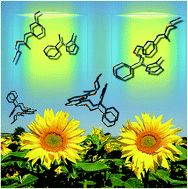Phototransformation of tetrazoline oxime ethers – part 2: theoretical investigation†
Abstract
The competitive photoisomerization and photodegradation reactions of a tetrazoline oxime ether showing important fungicidal activity are investigated by Time Dependent-Density Functional Theory (TD-DFT) and Complete Active Space Self-Consistent Field (CASSCF) calculations of ground state and excited state (singlet, S and triplet, T) potential energy surfaces. Two key experimental results reported previously are explained in this study: (1) why only E isomers undergo N–O bond scission and photodegradation and (2) what is the mechanism for deactivation of the Z isomers. In addition, the reactive pathway that involves intersystem crossing is shown to be competitive with reactions in the singlet state. Our results demonstrate that the photoreactivity (photodegradation or photoisomerization) of the eight conformers studied here is clearly related to the differences between the respective electronic configurations of the lowest singlet excited state. It is shown that the addition of a bulky substituent on the pyridyl group prevents E isomers from being photodegraded.


 Please wait while we load your content...
Please wait while we load your content...